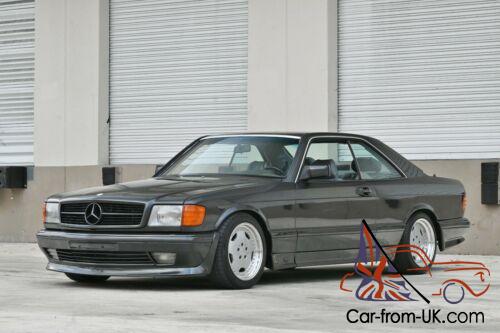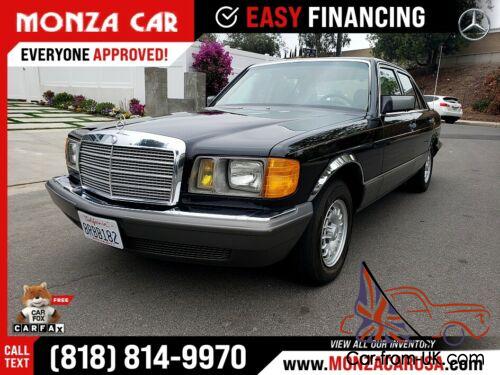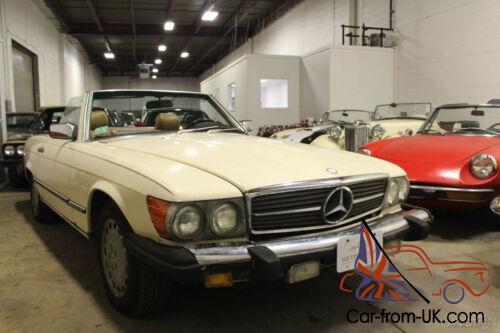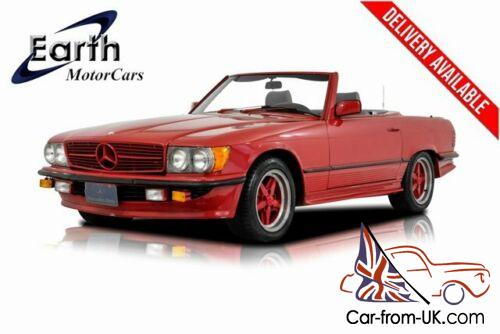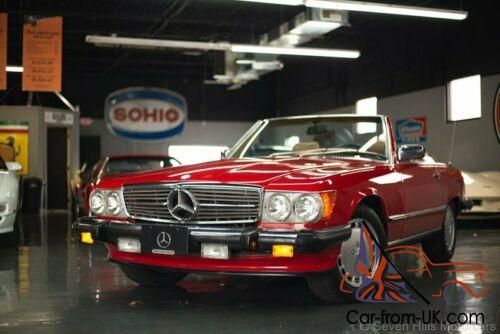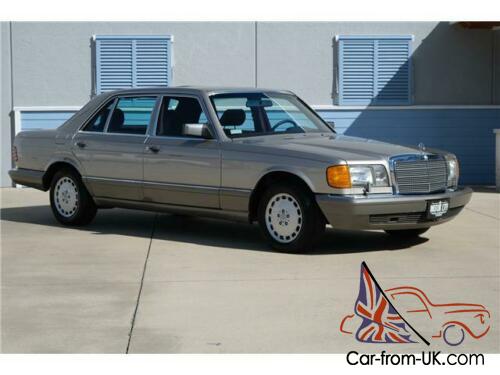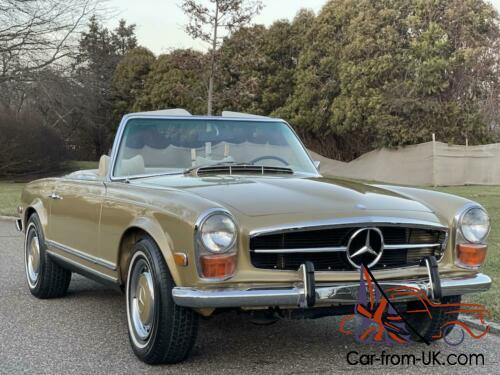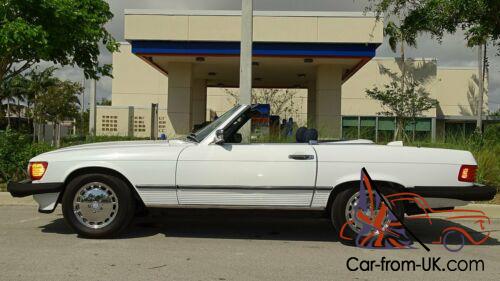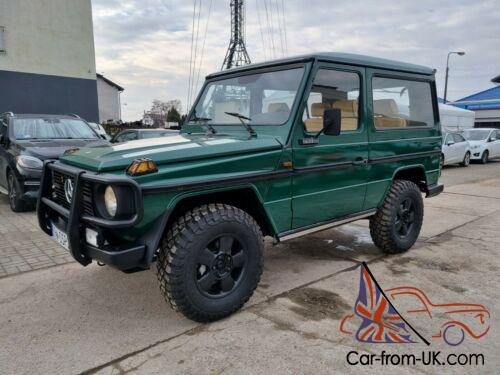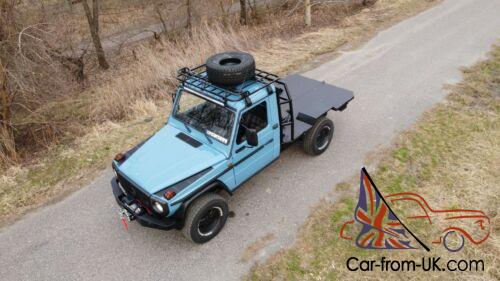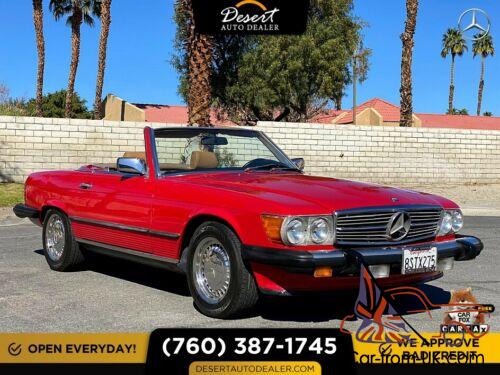Classic Cars / Mercedes-Benz / Car for sale
1977 Mercedes-Benz 450 SEL 6.9 No Rust
Sale price: $60,000.00 Make an offer
Car location: United States
Seller's notes: "Missing some Chrome,cracks in the dash and some wear on the seats, one air bag for hydraulics has a slight leak but does pump up, power antenna does not work, some damage on the seats. Runs great and has no rust and straight."
Sale type: Fixed price listing
Technical specifications, photos and description:
- Make:
- Mercedes-Benz
- Model:
- S-Class
- Year:
- 1977
- Type:
- Sedan
- Color:
- Brown
- Mileage:
- 86,622
- Engine:
- V-8
- Transmission:
- Automatic
- Fuel Type:
- Gasoline
- Safety Features:
- Anti-Lock Brakes
- Trim:
- chrome
- Interior Color:
- Brown
- Vehicle Title:
- Clear
- Got questions?
- Ask here!
1977 Mercedes-Benz 450 SEL 6.9 No Rust for sale
Current customer rating:
Mercedes-Benz 450 SEL 6. 9 From Wikipedia. the free encyclopedia
Mercedes-Benz 450 SEL 6. 9 Overview Manufacturer Daimler-Benz Production 1975–1981 Body and chassis Platform Mercedes-Benz W 116 Chronology Predecessor Mercedes-Benz 300 SEL 6. 3 Successor Mercedes-Benz 560 SEL
The Mercedes-Benz 450 SEL 6. 9 is a high-performance version of the S-Class luxury saloon. It was built on its own assembly line by Daimler-Benz in Stuttgart . Germany and based on the long-wheelbase version of the W 116 chassis introduced in 1972. The model was generally referred to in the company's literature as the "6. 9". to separate it from the regular 450 SEL.
The 6. 9 was first shown to the motoring press at the Geneva
Auto Show in 1974. and produced between 1975 and 1981 in extremely limited numbers. It was billed as the flagship of the Mercedes-Benz car line. and the successor to Mercedes-Benz 's original high-performance sedan. the 300 SEL 6. 3 . The 6. 9 also has the distinction of being among the first vehicles ever produced with optional electronically controlled anti-lock brakes . first introduced by Mercedes-Benz and Bosch in 1978. The 6. 9's successor — the top of range 500 SEL — continued the 6. 9's remarkable self-leveling
hydropneumatic suspension as an extra-cost option.
Contents
[ hide ]
1
Special features
2
M-100 power plant
3
Race track performance
4
Price and interior features
5
Today
6
Notable versions
7
Specifications
8
References
9
External links
Special features
[ edit ]
The 6. 9 was the first Mercedes-Benz to be fitted with the hydropneumatic
self-levelling suspension system introduced by Citroën in 1954. unlike the 600 and 6. 3 which employed air suspensions . Using a combination of fluid-filled struts and nitrogen-filled pressure vessels or " accumulators " in lieu of conventional shock absorbers and springs. the system was pressurized by a hydraulic pump driven by the engine's timing chain. Compared to the new Mercedes-Benz system. Citroën's was belt-driven. exactly like a conventional power steering pump failure of the Citroën system thus might result in loss of suspension. Conversely. every unit of the 6. 9 was shipped with hard rubber emergency dampers that served as temporary springs and allowed the car to be driven in the event of a hydraulic failure. The special hydraulic fluid required by the system was stored in a tank inside the engine compartment. Not only was the system totally self-adjusting. ride height could be altered by a dash-mounted push-pull knob under the speedometer that raised the car an additional two inches (50 mm) for increased ground clearance. The National Highway Traffic Safety Administration (NHTSA) made this feature illegal in the US market.
citation needed ] but it could be enabled simply by removing a limiter at the tank-mounted control valve.
US market 450 SEL 6. 9
The suspension system gave the 4200 pound (1900 kg) car the benefits of both a smooth ride and handling that allowed it. in the words of automotive journalist David E. Davis . to be "tossed about like a Mini . " The car also featured a model W 3 B 050 three-speed automatic transmission unique to the 6. 9 and a standard ZF limited slip differential both for enhanced roadholding performance on dry pavement and enhanced traction in inclement weather.
Four-wheel disc brakes and four-wheel independent suspension were standard across the W 116 model range.
M-100 power plant
[ edit ]
The engine was a cast iron
V 8 with single overhead camshafts operating sodium -filled valves against hardened valve seats on each aluminium alloy cylinder head. Each hand-built unit was bench-tested for 265 minutes. 40 of which were under full load. Bosch K-Jetronic electromechanical fuel injection was standard at a time when fuel-injected cars were uncommon. As in all Mercedes-Benz automobile engines. the crankshaft. connecting rods and pistons were forged instead of cast . In non-US trim. the 6. 9 l (6834 cc or 417 in³) power plant was conservatively rated at 286 hp (213 k W) with 405 lb·ft (549 N·m) of torque helping to compensate for the 2. 65 to 1 final drive ratio necessary for sustained high-speed cruising. The North American version. introduced in 1977. was rated with 36 fewer horsepower and 45 fewer lb·ft (250 and 360. respectively). due to more stringent emissions control requirements. In the interest of both engine longevity as well as creating some extra space under the hood. a " dry sump " engine lubrication system was used. The system circulated twelve quarts of oil between the storage tank and the engine. as opposed to the usual four or five quarts found in V 8 s with a standard oil pan and oil pump. As a result. the engine itself had no dipstick for checking the oil level. Rather. the dipstick was attached to the inside of the tank's filler cap (accessible from the engine compartment) and the oil level was checked with the engine running and at operating temperature . The dry sump system also had the benefit of extending the oil change interval to 12. 00 miles (20. 00 km). This. along with hydraulic valve lifters which required no adjusting and special cylinder head gaskets which eliminated the need for periodic retorquing of the head bolts. made the 6. 9 nearly maintenance-free for its first 50. 00 miles (80. 00 km). The 6. 9 required little basic service other than coolant. minor tune-ups. oil changes. and replacement of the air. fuel. oil and power steering filters.
Race track performance
[ edit ]
Top speed was factory-rated at 140 mph (225 km/h). but some journalists testing the car saw speeds approaching 150 mph (241 km/h). Among those journalists was Brock Yates . Yates was approached by the factory to write promotional literature about the 6. 9. He agreed. but under the condition that he could list the car's faults as well as its positives. Daimler-Benz agreed in turn. and Yates was given a US-spec 6. 9 to drive from Manhattan to the Road Atlanta grand prix race track in Georgia . There. Yates would drive the car in as-arrived condition at racing speeds for a full 40 laps or just over 100 miles (160 km). The only change made to the car upon its arrival at Road Atlanta was the necessary adjustment of tire pressure. Driving 40 laps was a difficult task even for a purpose-built race car. let alone a street-legal sedan designed and geared for high-speed Autobahn cruising. The 6. 9 suffered no mechanical problems and averaged a very respectable 72 mph (116 km/h) throughout the test. completing it with little more than excess dust on the bodywork from the Michelin
radial street tires on which the car was driven to Atlanta. Yates was so comfortable driving the 6. 9 around the track that he reported having run at least one lap with the sunroof open and the radio on. but the high price of the car made him think better of such risky driving and he finished the test with the radio off and both hands on the wheel. [1]
Price and interior features
[ edit ]
The dashboard of a Mercedes-Benz 450 SEL 6. 9. US version.
All of this technology came at a very high price. At a time when the most expensive Cadillacs . the mid-sized Seville and full-sized
Cadillac Fleetwood
Series Seventy-Five
limousine each listed for about US$16. 00. the 6. 9 listed for around $40. 00. more than the Big Three but less than most Rolls-Royces . When the car was officially introduced into the North American market for the 1977 model year. the price was well past $40. 00 and was $52. 95 by the end of production. The only way to get a 6. 9 in the US or Canada prior to 1977 was to import one through the grey market . Though the 6. 9 was undeniably a luxury car. it was a rather austere one compared to the sheer opulence available in a Rolls-Royce or full-sized Cadillac. The interior was identical to that in the less expensive models except for the push-pull suspension control knob just under the speedometer. a low suspension pressure warning and height adjustment indicator lights in the instrument cluster. and wood trim finished in burled walnut veneer on the dash and console. The rest of the W 116 lineup was trimmed in striated zebrano veneer.
The 6. 9 lacked expected luxury touches such as power-adjustable outside mirrors or front seats. although a unique power rear seat. heated seats and even orthopedically designed front seats were options. Buyers outside North America could also opt for headlight wipers and washers and/or headlights with a special vacuum-operated linkage whose aim could be adjusted at the dash depending on vehicle load. There was also a new standard feature in 1976: most Mercedes-Benz automobiles that year were equipped with a sophisticated electronic climate control system developed by Chrysler Corporation for use in their top models. The system turned on the heater. air conditioner or both. depending on the thermostat's setting and ambient temperature. automatically maintaining whatever temperature the driver selected. The compressor was an American import as well. supplied by the Harrison division of General Motors .
Far more modern than the contemporary Cadillac. which still had a live rear axle . and both faster and larger inside than the either the Rolls-Royce or Cadillac. the 6. 9 was indistinguishable from its W 116 stablemates save for a modest "6. 9" badge on the decklid and wider tires. [2] US models also had different bumper rubbers fitted to the "park bench" impact absorbing bumpers. As discreet as the badge was. it could be deleted/ordered with option 261 omission of the displacement figure on the trunk lid at extra cost for those who wanted to avoid attention either from drivers of other high-performance cars or from law enforcement. In the words of David E. Davis . the 6. 9 was "a $50. 00 exercise in going fast. "
Still. for fans of the discontinued 6. 3 or for those who simply had to have a car which Car and Driver proclaimed to be "the greatest Mercedes-Benz ever built. it seemed that money was no object. At its launch in 1975. the 450 SEL 6. 9 cost DM 69. 30. In the last year of production. 1979. the car was available at a price of DM 81. 47. Even though this was far from inexpensive. the courage of the Mercedes-Benz strategists in launching the car onto the market paid off. A total of 7. 80 units were built by 1980. and most of these were exported to the USA. This volume figure looks rather small at first glance. but production figures tend to be significantly smaller in the top luxury segment where this model competes. Also. the 6. 9 was not the only S-Class model. and was purchased by the rich. the famous. and the powerful despite the rising cost of gasoline brought on by the Arab oil embargo . Thus. the 7. 80 total sales volume is quite respectable once the price and contemporary economic climate are taken into account.
Today
[ edit ]
In a poll conducted by Britain's Classic & Sports Car magazine and printed in their April 1999 edition. the Mercedes-Benz 6. 9 ranked fourth on their list of the "world's greatest saloons . " [3] The May 2004 edition of another British publication. Mercedes Enthusiast magazine. ranked the 6. 9 number fifteen on their all-time top twenty list of great Mercedes-Benz automobiles. Even with such accolades. a 6. 9 is a reasonably priced collectible automobile despite its rarity. The online NADA Used Car Guide lists a top value of US$20. 00. At present. the market for cars of this type is somewhat soft. and a prime example can be had for considerably less. As is often the case with older cars that contain exotic engineering and parts unique to that one model. however. running and maintenance costs for a 6. 9 can quickly overshadow a low initial purchase price.
Notable versions
[ edit ] In 1976. French film director Claude Lelouch attached a camera to the front bumper of a 6. 9 and drove it at high speed through the streets of Paris at daybreak. The resulting nine-minute one-take cinéma vérité film. C'était un rendez-vous . was greeted with moral outrage over the apparent risks taken by Lelouch as he sped past pedestrians and other vehicles. However. the sound of a five-speed Ferrari 275 GTB was dubbed over the three-speed 6. 9. Careful investigation of the film furthermore shows. that the actual driving speed was not that high. There were never any plans to build a station wagon version of the W 116. 6. 9 or otherwise. owing both to the location of the fuel tank ahead of the rear axle and the overwhelming demand for the sedan versions. Still. a number of W 116 s were converted to station wagons by coach builders in Germany and England (see [1] for details of the English conversions). In 1977. a German diplomat named Manfred Sittmann commissioned Brinkmann Karosserie in Bremen to build a 6. 9 station wagon. or "estate car. " Sittmann frequently travelled with two large dogs and a family entourage to Italy. German motorsports magazine Auto. Motor und Sport learned of the car and requested an interview with Mr Sittmann and a photo shoot as well. The magazine's feature would be titled "Die teuerste Hundehütte. or "The Most Expensive Doghouse. " This one-off 6. 9 currently[ when? ] sees regular use with its third owner. a Mercedes-Benz collector in Pennsylvania. Another 450 SEL 6. 9 was converted to station wagon form for actress Sophia Loren—complete with mesh dog-guard to prevent her hounds climbing into the passenger area (see [2] for details). The 1998 action film Ronin features a car chase where a Mercedes 6. 9 is driven by the protagonists who perform high-speed driving through mountain roads and inside a French town. all with dramatic stunts ( drifting . J-turns . etc. ). In David Lynch 's 1996 film. Lost Highway . a Mercedes 6. 9 is used as a major plot device. ultimately connecting all three main male characters of the movie. In one scene. the hood is opened to reveal an after-market modification. bringing the engine power to "1400 horsepower". according to one character. In another scene. the car is used to push a Ford Thunderbird off the road. despite the latter applying the brakes. [4] [5] [6] The last Shah of Iran had at least two armoured car versions of the vehicle. with one later put up for auction in New York City Claude Francois . French singer and composer of Comme d'habitude (the original version of My Way ) drove a 450 SEL 6. 9 from November 1976 till March 1978. He was attacked in this car in 1977. and after escaping several bullet holes were later found in various areas of the car The actor Telly Savalas negotiated a 6. 9 and 450 SL in exchange for two days of promotional work for Mercedes Benz
Noted owners included: Sir Bernard Ashley James Hunt [7]
John F. Kennedy. Jr. Frank Sinatra . Vladimir Vysotsky
Specifications
[ edit ] Mercedes-Benz 450 SEL 6. 9 [8] Manufacturer Daimler-Benz AG Class Five-passenger. four-door luxury sedan Body Styles Four-door sedan Predecessor 300 SEL 6. 3 Successor None Shares components with Mercedes-Benz 600 . Mercedes-Benz 300 SEL 6. 3 . other Mercedes-Benz W 116 sedans Wheelbase:116. 5 in 2960 mm Front track 59. 9 in 1521 mm Rear track 59. 3 in 1505 mm Overall length:210 in 5335 mm Width:73. 6 in 1870 mm Curb weight:4390 lb 1985 kg Fuel tank capacity 25. 3 US gal 95 LTrunk (boot) capacity 18. 2 ft³0. 52 m³Battery capacity 12 V. 88 A·h Steering wheel turns 2. 7 lock-to-lock Turning circle 40 ft 12. 1 m Head Room - Front 38. 6 in 980 mm Leg Room - Front 41. 7 in 1060 mm Hip Room - Front 57. 5 in 1460 mm Shoulder Room - Front 55. 1 in 1400 mm Head Room - Rear 37. 1 in 942 mm Leg Room - Rear 38. 1 in 967 mm Hip Room - Rear 59. 5 in 1510 mm Shoulder Room - Rear 54. 9 in 1394 mm Engine V-8. Bosch fuel injection. electronic ignition. two single overhead camshafts. five main bearings Net power 4250 rpm
(World)286 PS 210 k WNet torque 3000 rpm
(World)405 lbf·ft 549 Nm Net power 4000 rpm
(North America)250 hp 186 k WNet torque 2500 rpm
(North America):360 lbf·ft 488 Nm Compression ratio
(World)8. 8:1 Compression ratio
(North America)8. 0:1 Bore/stroke 4. 21 × 3. 74 in 107 × 95 mm Displacement 417. 1 in³6834 cc Maximum engine speed 5300 rpm Transmission:Three-speed automatic with torque converter Rear axle ratio 2. 65:1 Tires and wheels Michelin XWX 215/70 VR 14 steel-belted radial 6. 5 Jx 14 light alloy Braking system Dual-circuit. power-assisted hydraulic. four-wheel disc brakes. Front discs ventilated. Total swept brake area 456. 5 in²2945 cm²0-60 mph (0–96 km/h)7. 1 seconds Top speed (World)225 km/h (139. 8 mph)Production World North America
198140 Total 73801816 References
[ edit ]
Jump up ^
Brock Yates' 6. 9 Evaluation. from 6. 9 Promotional Literature from Mercedes-Benz
Jump up ^
David E. Davis Jr. (July 1977). Mercedes-Benz 450 SEL 6. 9 - Archived Road Test . Car and Driver
Jump up ^
Classic & Sports Car. April 1997 - Best Saloons Ever
Jump up ^
IMCDB
Jump up ^
Motoring Con Brio
Jump up ^
Mercedes in the Movies
Jump up ^
channel 4. com/4 car/used-cars/classics/mercedes-sclass/sclass-2. html
Jump up ^
Oswald. Werner (2003). Deutsche Autos 1945-1990. Band 4. Stuttgart: Motorbuch Verlag. pp. 80. 86.
ISBN
3-613-02131-5 .
External links
[ edit ]
International M-100 Group — Factory-authorized site with information on all M-100-powered Mercedes-Benz automobiles. (including technical forums and maintenance information). The Brock Yates article can be found here as well A Mercedes for the '70 s: The W 116 Series S-Class — A site mixing the history of the full-scale W 116 with that of its many miniature replicas. Classic Car driver review Curbside Classic: 1977 Mercedes 450 SEL 6. 9 – Deutsches Heavy Metal – a retrospective of the 450 SEL 6. 9 Golden Brown: Four Days in a Mercedes-Benz 450 SEL 6. 9 - Feature (Car and Driver) [ hide ]
v
t
e
« previous — Mercedes-Benz road car timeline. 1990 s–present Model Body 1990 s 2000 s 2010 s 0123 A Hatch W 168 W 169 W 176 B W 245 W 246 C Saloon W 201 W 202 W 203 W 204 Estate S 202 S 203 S 204 E Saloon W 124 W 210 W 211 W 212 Limousine V 124 V 212 Estate S 124 S 210 S 211 S 212 S Saloon W 126 W 140 W 220 W 221 W 222 Limousine V 126 V 140 V 220 V 221 V 222 Pullman VF 140 VF 220 VF 221 CLA Coupé C 117 CLC / C CL 203 CL 203 C 204 CLK / E C 124 C 208 C 209 C 207 Cabriolet A 124 A 208 A 209 A 207 CLS Coupé W 219 W 218 CL C 126 C 140 C 215 C 216 SLK Roadster R 170 R 171 R 172 SL R 129 R 230 R 231 SLS Coupé C 197 Roadster R 197 SLR Coupé C 199 Roadster R 199 Speedster Z 199 Vaneo MPV W 414 R W 251 GLK SUV X 204 M W 163 W 164 W 166 GL X 164 X 166 G W 460/461 W 463 Citan LCV W 415 Vito MB 100 W 638 W 639 Sprinter T 1 W 901 - W 905 NCV 3 Vario T 2 W 670 Model Body 01231990 s 2000 s 2010 s Categories : Mercedes-Benz vehicles Rear-wheel-drive vehicles
Mercedes-Benz 450 SEL 6. 9 Overview Manufacturer Daimler-Benz Production 1975–1981 Body and chassis Platform Mercedes-Benz W 116 Chronology Predecessor Mercedes-Benz 300 SEL 6. 3 Successor Mercedes-Benz 560 SEL
The Mercedes-Benz 450 SEL 6. 9 is a high-performance version of the S-Class luxury saloon. It was built on its own assembly line by Daimler-Benz in Stuttgart . Germany and based on the long-wheelbase version of the W 116 chassis introduced in 1972. The model was generally referred to in the company's literature as the "6. 9". to separate it from the regular 450 SEL.
The 6. 9 was first shown to the motoring press at the Geneva
Auto Show in 1974. and produced between 1975 and 1981 in extremely limited numbers. It was billed as the flagship of the Mercedes-Benz car line. and the successor to Mercedes-Benz 's original high-performance sedan. the 300 SEL 6. 3 . The 6. 9 also has the distinction of being among the first vehicles ever produced with optional electronically controlled anti-lock brakes . first introduced by Mercedes-Benz and Bosch in 1978. The 6. 9's successor — the top of range 500 SEL — continued the 6. 9's remarkable self-leveling
hydropneumatic suspension as an extra-cost option.
Contents
[ hide ]
1
Special features
2
M-100 power plant
3
Race track performance
4
Price and interior features
5
Today
6
Notable versions
7
Specifications
8
References
9
External links
Special features
[ edit ]
The 6. 9 was the first Mercedes-Benz to be fitted with the hydropneumatic
self-levelling suspension system introduced by Citroën in 1954. unlike the 600 and 6. 3 which employed air suspensions . Using a combination of fluid-filled struts and nitrogen-filled pressure vessels or " accumulators " in lieu of conventional shock absorbers and springs. the system was pressurized by a hydraulic pump driven by the engine's timing chain. Compared to the new Mercedes-Benz system. Citroën's was belt-driven. exactly like a conventional power steering pump failure of the Citroën system thus might result in loss of suspension. Conversely. every unit of the 6. 9 was shipped with hard rubber emergency dampers that served as temporary springs and allowed the car to be driven in the event of a hydraulic failure. The special hydraulic fluid required by the system was stored in a tank inside the engine compartment. Not only was the system totally self-adjusting. ride height could be altered by a dash-mounted push-pull knob under the speedometer that raised the car an additional two inches (50 mm) for increased ground clearance. The National Highway Traffic Safety Administration (NHTSA) made this feature illegal in the US market.
citation needed ] but it could be enabled simply by removing a limiter at the tank-mounted control valve.
US market 450 SEL 6. 9
The suspension system gave the 4200 pound (1900 kg) car the benefits of both a smooth ride and handling that allowed it. in the words of automotive journalist David E. Davis . to be "tossed about like a Mini . " The car also featured a model W 3 B 050 three-speed automatic transmission unique to the 6. 9 and a standard ZF limited slip differential both for enhanced roadholding performance on dry pavement and enhanced traction in inclement weather.
Four-wheel disc brakes and four-wheel independent suspension were standard across the W 116 model range.
M-100 power plant
[ edit ]
The engine was a cast iron
V 8 with single overhead camshafts operating sodium -filled valves against hardened valve seats on each aluminium alloy cylinder head. Each hand-built unit was bench-tested for 265 minutes. 40 of which were under full load. Bosch K-Jetronic electromechanical fuel injection was standard at a time when fuel-injected cars were uncommon. As in all Mercedes-Benz automobile engines. the crankshaft. connecting rods and pistons were forged instead of cast . In non-US trim. the 6. 9 l (6834 cc or 417 in³) power plant was conservatively rated at 286 hp (213 k W) with 405 lb·ft (549 N·m) of torque helping to compensate for the 2. 65 to 1 final drive ratio necessary for sustained high-speed cruising. The North American version. introduced in 1977. was rated with 36 fewer horsepower and 45 fewer lb·ft (250 and 360. respectively). due to more stringent emissions control requirements. In the interest of both engine longevity as well as creating some extra space under the hood. a " dry sump " engine lubrication system was used. The system circulated twelve quarts of oil between the storage tank and the engine. as opposed to the usual four or five quarts found in V 8 s with a standard oil pan and oil pump. As a result. the engine itself had no dipstick for checking the oil level. Rather. the dipstick was attached to the inside of the tank's filler cap (accessible from the engine compartment) and the oil level was checked with the engine running and at operating temperature . The dry sump system also had the benefit of extending the oil change interval to 12. 00 miles (20. 00 km). This. along with hydraulic valve lifters which required no adjusting and special cylinder head gaskets which eliminated the need for periodic retorquing of the head bolts. made the 6. 9 nearly maintenance-free for its first 50. 00 miles (80. 00 km). The 6. 9 required little basic service other than coolant. minor tune-ups. oil changes. and replacement of the air. fuel. oil and power steering filters.
Race track performance
[ edit ]
Top speed was factory-rated at 140 mph (225 km/h). but some journalists testing the car saw speeds approaching 150 mph (241 km/h). Among those journalists was Brock Yates . Yates was approached by the factory to write promotional literature about the 6. 9. He agreed. but under the condition that he could list the car's faults as well as its positives. Daimler-Benz agreed in turn. and Yates was given a US-spec 6. 9 to drive from Manhattan to the Road Atlanta grand prix race track in Georgia . There. Yates would drive the car in as-arrived condition at racing speeds for a full 40 laps or just over 100 miles (160 km). The only change made to the car upon its arrival at Road Atlanta was the necessary adjustment of tire pressure. Driving 40 laps was a difficult task even for a purpose-built race car. let alone a street-legal sedan designed and geared for high-speed Autobahn cruising. The 6. 9 suffered no mechanical problems and averaged a very respectable 72 mph (116 km/h) throughout the test. completing it with little more than excess dust on the bodywork from the Michelin
radial street tires on which the car was driven to Atlanta. Yates was so comfortable driving the 6. 9 around the track that he reported having run at least one lap with the sunroof open and the radio on. but the high price of the car made him think better of such risky driving and he finished the test with the radio off and both hands on the wheel. [1]
Price and interior features
[ edit ]
The dashboard of a Mercedes-Benz 450 SEL 6. 9. US version.
All of this technology came at a very high price. At a time when the most expensive Cadillacs . the mid-sized Seville and full-sized
Cadillac Fleetwood
Series Seventy-Five
limousine each listed for about US$16. 00. the 6. 9 listed for around $40. 00. more than the Big Three but less than most Rolls-Royces . When the car was officially introduced into the North American market for the 1977 model year. the price was well past $40. 00 and was $52. 95 by the end of production. The only way to get a 6. 9 in the US or Canada prior to 1977 was to import one through the grey market . Though the 6. 9 was undeniably a luxury car. it was a rather austere one compared to the sheer opulence available in a Rolls-Royce or full-sized Cadillac. The interior was identical to that in the less expensive models except for the push-pull suspension control knob just under the speedometer. a low suspension pressure warning and height adjustment indicator lights in the instrument cluster. and wood trim finished in burled walnut veneer on the dash and console. The rest of the W 116 lineup was trimmed in striated zebrano veneer.
The 6. 9 lacked expected luxury touches such as power-adjustable outside mirrors or front seats. although a unique power rear seat. heated seats and even orthopedically designed front seats were options. Buyers outside North America could also opt for headlight wipers and washers and/or headlights with a special vacuum-operated linkage whose aim could be adjusted at the dash depending on vehicle load. There was also a new standard feature in 1976: most Mercedes-Benz automobiles that year were equipped with a sophisticated electronic climate control system developed by Chrysler Corporation for use in their top models. The system turned on the heater. air conditioner or both. depending on the thermostat's setting and ambient temperature. automatically maintaining whatever temperature the driver selected. The compressor was an American import as well. supplied by the Harrison division of General Motors .
Far more modern than the contemporary Cadillac. which still had a live rear axle . and both faster and larger inside than the either the Rolls-Royce or Cadillac. the 6. 9 was indistinguishable from its W 116 stablemates save for a modest "6. 9" badge on the decklid and wider tires. [2] US models also had different bumper rubbers fitted to the "park bench" impact absorbing bumpers. As discreet as the badge was. it could be deleted/ordered with option 261 omission of the displacement figure on the trunk lid at extra cost for those who wanted to avoid attention either from drivers of other high-performance cars or from law enforcement. In the words of David E. Davis . the 6. 9 was "a $50. 00 exercise in going fast. "
Still. for fans of the discontinued 6. 3 or for those who simply had to have a car which Car and Driver proclaimed to be "the greatest Mercedes-Benz ever built. it seemed that money was no object. At its launch in 1975. the 450 SEL 6. 9 cost DM 69. 30. In the last year of production. 1979. the car was available at a price of DM 81. 47. Even though this was far from inexpensive. the courage of the Mercedes-Benz strategists in launching the car onto the market paid off. A total of 7. 80 units were built by 1980. and most of these were exported to the USA. This volume figure looks rather small at first glance. but production figures tend to be significantly smaller in the top luxury segment where this model competes. Also. the 6. 9 was not the only S-Class model. and was purchased by the rich. the famous. and the powerful despite the rising cost of gasoline brought on by the Arab oil embargo . Thus. the 7. 80 total sales volume is quite respectable once the price and contemporary economic climate are taken into account.
Today
[ edit ]
In a poll conducted by Britain's Classic & Sports Car magazine and printed in their April 1999 edition. the Mercedes-Benz 6. 9 ranked fourth on their list of the "world's greatest saloons . " [3] The May 2004 edition of another British publication. Mercedes Enthusiast magazine. ranked the 6. 9 number fifteen on their all-time top twenty list of great Mercedes-Benz automobiles. Even with such accolades. a 6. 9 is a reasonably priced collectible automobile despite its rarity. The online NADA Used Car Guide lists a top value of US$20. 00. At present. the market for cars of this type is somewhat soft. and a prime example can be had for considerably less. As is often the case with older cars that contain exotic engineering and parts unique to that one model. however. running and maintenance costs for a 6. 9 can quickly overshadow a low initial purchase price.
Notable versions
[ edit ] In 1976. French film director Claude Lelouch attached a camera to the front bumper of a 6. 9 and drove it at high speed through the streets of Paris at daybreak. The resulting nine-minute one-take cinéma vérité film. C'était un rendez-vous . was greeted with moral outrage over the apparent risks taken by Lelouch as he sped past pedestrians and other vehicles. However. the sound of a five-speed Ferrari 275 GTB was dubbed over the three-speed 6. 9. Careful investigation of the film furthermore shows. that the actual driving speed was not that high. There were never any plans to build a station wagon version of the W 116. 6. 9 or otherwise. owing both to the location of the fuel tank ahead of the rear axle and the overwhelming demand for the sedan versions. Still. a number of W 116 s were converted to station wagons by coach builders in Germany and England (see [1] for details of the English conversions). In 1977. a German diplomat named Manfred Sittmann commissioned Brinkmann Karosserie in Bremen to build a 6. 9 station wagon. or "estate car. " Sittmann frequently travelled with two large dogs and a family entourage to Italy. German motorsports magazine Auto. Motor und Sport learned of the car and requested an interview with Mr Sittmann and a photo shoot as well. The magazine's feature would be titled "Die teuerste Hundehütte. or "The Most Expensive Doghouse. " This one-off 6. 9 currently[ when? ] sees regular use with its third owner. a Mercedes-Benz collector in Pennsylvania. Another 450 SEL 6. 9 was converted to station wagon form for actress Sophia Loren—complete with mesh dog-guard to prevent her hounds climbing into the passenger area (see [2] for details). The 1998 action film Ronin features a car chase where a Mercedes 6. 9 is driven by the protagonists who perform high-speed driving through mountain roads and inside a French town. all with dramatic stunts ( drifting . J-turns . etc. ). In David Lynch 's 1996 film. Lost Highway . a Mercedes 6. 9 is used as a major plot device. ultimately connecting all three main male characters of the movie. In one scene. the hood is opened to reveal an after-market modification. bringing the engine power to "1400 horsepower". according to one character. In another scene. the car is used to push a Ford Thunderbird off the road. despite the latter applying the brakes. [4] [5] [6] The last Shah of Iran had at least two armoured car versions of the vehicle. with one later put up for auction in New York City Claude Francois . French singer and composer of Comme d'habitude (the original version of My Way ) drove a 450 SEL 6. 9 from November 1976 till March 1978. He was attacked in this car in 1977. and after escaping several bullet holes were later found in various areas of the car The actor Telly Savalas negotiated a 6. 9 and 450 SL in exchange for two days of promotional work for Mercedes Benz
Noted owners included: Sir Bernard Ashley James Hunt [7]
John F. Kennedy. Jr. Frank Sinatra . Vladimir Vysotsky
Specifications
[ edit ] Mercedes-Benz 450 SEL 6. 9 [8] Manufacturer Daimler-Benz AG Class Five-passenger. four-door luxury sedan Body Styles Four-door sedan Predecessor 300 SEL 6. 3 Successor None Shares components with Mercedes-Benz 600 . Mercedes-Benz 300 SEL 6. 3 . other Mercedes-Benz W 116 sedans Wheelbase:116. 5 in 2960 mm Front track 59. 9 in 1521 mm Rear track 59. 3 in 1505 mm Overall length:210 in 5335 mm Width:73. 6 in 1870 mm Curb weight:4390 lb 1985 kg Fuel tank capacity 25. 3 US gal 95 LTrunk (boot) capacity 18. 2 ft³0. 52 m³Battery capacity 12 V. 88 A·h Steering wheel turns 2. 7 lock-to-lock Turning circle 40 ft 12. 1 m Head Room - Front 38. 6 in 980 mm Leg Room - Front 41. 7 in 1060 mm Hip Room - Front 57. 5 in 1460 mm Shoulder Room - Front 55. 1 in 1400 mm Head Room - Rear 37. 1 in 942 mm Leg Room - Rear 38. 1 in 967 mm Hip Room - Rear 59. 5 in 1510 mm Shoulder Room - Rear 54. 9 in 1394 mm Engine V-8. Bosch fuel injection. electronic ignition. two single overhead camshafts. five main bearings Net power 4250 rpm
(World)286 PS 210 k WNet torque 3000 rpm
(World)405 lbf·ft 549 Nm Net power 4000 rpm
(North America)250 hp 186 k WNet torque 2500 rpm
(North America):360 lbf·ft 488 Nm Compression ratio
(World)8. 8:1 Compression ratio
(North America)8. 0:1 Bore/stroke 4. 21 × 3. 74 in 107 × 95 mm Displacement 417. 1 in³6834 cc Maximum engine speed 5300 rpm Transmission:Three-speed automatic with torque converter Rear axle ratio 2. 65:1 Tires and wheels Michelin XWX 215/70 VR 14 steel-belted radial 6. 5 Jx 14 light alloy Braking system Dual-circuit. power-assisted hydraulic. four-wheel disc brakes. Front discs ventilated. Total swept brake area 456. 5 in²2945 cm²0-60 mph (0–96 km/h)7. 1 seconds Top speed (World)225 km/h (139. 8 mph)Production World North America
198140 Total 73801816 References
[ edit ]
Jump up ^
Brock Yates' 6. 9 Evaluation. from 6. 9 Promotional Literature from Mercedes-Benz
Jump up ^
David E. Davis Jr. (July 1977). Mercedes-Benz 450 SEL 6. 9 - Archived Road Test . Car and Driver
Jump up ^
Classic & Sports Car. April 1997 - Best Saloons Ever
Jump up ^
IMCDB
Jump up ^
Motoring Con Brio
Jump up ^
Mercedes in the Movies
Jump up ^
channel 4. com/4 car/used-cars/classics/mercedes-sclass/sclass-2. html
Jump up ^
Oswald. Werner (2003). Deutsche Autos 1945-1990. Band 4. Stuttgart: Motorbuch Verlag. pp. 80. 86.
ISBN
3-613-02131-5 .
External links
[ edit ]
International M-100 Group — Factory-authorized site with information on all M-100-powered Mercedes-Benz automobiles. (including technical forums and maintenance information). The Brock Yates article can be found here as well A Mercedes for the '70 s: The W 116 Series S-Class — A site mixing the history of the full-scale W 116 with that of its many miniature replicas. Classic Car driver review Curbside Classic: 1977 Mercedes 450 SEL 6. 9 – Deutsches Heavy Metal – a retrospective of the 450 SEL 6. 9 Golden Brown: Four Days in a Mercedes-Benz 450 SEL 6. 9 - Feature (Car and Driver) [ hide ]
v
t
e
« previous — Mercedes-Benz road car timeline. 1990 s–present Model Body 1990 s 2000 s 2010 s 0123 A Hatch W 168 W 169 W 176 B W 245 W 246 C Saloon W 201 W 202 W 203 W 204 Estate S 202 S 203 S 204 E Saloon W 124 W 210 W 211 W 212 Limousine V 124 V 212 Estate S 124 S 210 S 211 S 212 S Saloon W 126 W 140 W 220 W 221 W 222 Limousine V 126 V 140 V 220 V 221 V 222 Pullman VF 140 VF 220 VF 221 CLA Coupé C 117 CLC / C CL 203 CL 203 C 204 CLK / E C 124 C 208 C 209 C 207 Cabriolet A 124 A 208 A 209 A 207 CLS Coupé W 219 W 218 CL C 126 C 140 C 215 C 216 SLK Roadster R 170 R 171 R 172 SL R 129 R 230 R 231 SLS Coupé C 197 Roadster R 197 SLR Coupé C 199 Roadster R 199 Speedster Z 199 Vaneo MPV W 414 R W 251 GLK SUV X 204 M W 163 W 164 W 166 GL X 164 X 166 G W 460/461 W 463 Citan LCV W 415 Vito MB 100 W 638 W 639 Sprinter T 1 W 901 - W 905 NCV 3 Vario T 2 W 670 Model Body 01231990 s 2000 s 2010 s Categories : Mercedes-Benz vehicles Rear-wheel-drive vehicles
Want to buy this car?
Comments and questions to the seller:
Other classic Mercedes-Benz cars offered via internet auctions:
 price: $93,995.001969 Mercedes-Benz SL-Class
price: $93,995.001969 Mercedes-Benz SL-Class price: $6,500.001985 Mercedes-Benz 500-Series
price: $6,500.001985 Mercedes-Benz 500-Series price: $29,950.001967 Mercedes-Benz 250SL
price: $29,950.001967 Mercedes-Benz 250SL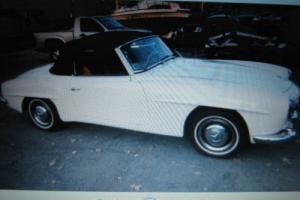 price: $US $50,000.001959 Mercedes-Benz SL-Class
price: $US $50,000.001959 Mercedes-Benz SL-Class
Latest arrivals:
-
$42,900.000
-
$7,100.000
-
$7,100.000
-
$7,099.000
-
$27,995.000
-
$42,499.000
-
$6,900.000
-
$23,900.000
-
$37,900.000
-
$135,000.000
-
$24,900.000
-
$185,000.000
-
$8,000.000
-
$149,000.000
-
$57,000.000
-
$24,999.000
-
$57,900.000
-
$7,900.000
-
$7,100.000
-
$27,000.000








